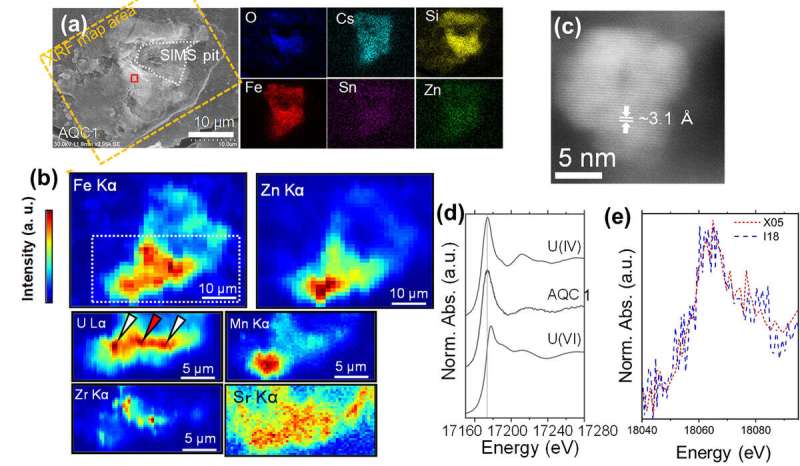Particulate plutonium released from the Fukushima Daiichi meltdowns

Small amounts of plutonium (Pu) were released from the damaged Fukushima Daiichi Nuclear Power Plant (FDNPP) reactors into the environment during the site's 2011 nuclear disaster. However, the physical, chemical, and isotopic form of the released Pu has remained unknown.
Now, recent work published in the journal Science of the Total Environment has shown that Pu was included inside cesium-rich microparticles (CsMPs) that were emitted from the site. CsMPs are microscopic radioactive particles that formed inside the Fukushima reactors when the melting nuclear fuel interacted with the reactor's structural concrete. Due to loss of containment in the reactors, the particles were released into the atmosphere; many were then deposited across Japan.
Studies have shown that the CsMPs are incredibly radioactive and that they are primarily composed of glass (with silica from the concrete) and radio-cesium (a volatile fission product formed in the reactors). Whilst the environmental impact and distribution of the CsMPs is still an active subject of debate, learning about the chemical composition of the CsMPs has been shown to offer a much-needed insight into the nature and extent of the FDNPP meltdowns.
The study published in Science of the Total Environment, involving scientists from Japan, Finland, France, Switzerland, the UK, and U.S., was led by Dr. Satoshi Utsunomiya and graduate student Eitaro Kurihara (Department of Chemistry, Kyushu University). The team used a combination of advanced analytical techniques (synchrotron-based micro-X-ray analysis, secondary ion mass spectrometry, and high-resolution transmission electron microscopy) to find and characterize the Pu that was present in the CsMP samples.
The researchers initially discovered incredibly small uranium-dioxide inclusions, of less than 10 nanometers in diameter, inside the CsMPs; this indicated possible inclusion of nuclear fuel inside the particles. Detailed analysis then revealed, for the first-time, that Pu-oxide concentrates were associated with the uranium, and that the isotopic composition of the U and Pu matched that calculated for the FDNPP irradiated fuel inventory.
Dr. Utsunomiya stated "these results strongly suggest that the nano-scale heterogeneity that is common in normal nuclear fuels is still present in the fuel debris that remains inside the site's damaged reactors. This is important information as it tells us about the extent / severity of the melt-down. Further, this is important information for the eventual decommissioning of the damaged reactors and the long-term management of their wastes."
With regards environmental impact, Dr. Utsunomiya states "that as we already know that the CsMPs were distributed over a wide region in Japan (up to 230 km from the FDNPP), small amounts of Pu were likely dispersed in the same way."
Professor Gareth Law, a co-author on the paper from the University of Helsinki, indicated that the team "will continue to characterize and experiment with the CsMPs, in an effort to better understand their long-term behavior and environmental impact. It is clear that CsMPs are an important vector of radioactive contamination from nuclear accidents."
Professor Bernd Grambow, a co-author from Nantes/France, states that "while the Pu released from the damaged reactors is low compared to that of Cs; the investigation provides crucial information for studying the associated health impact."
Professor Rod Ewing at Stanford University emphasized that "the study used an extraordinary array of analytical techniques in order to complete the description of the particles at the atomic-scale. This is the type of information required to describe the mobility of plutonium in the environment."
Utsunomiya concluded "It took a long time to publish results on particulate Pu from Fukushima. I would like to emphasize that this is a great achievement of international collaboration. It's been almost ten years since the nuclear disaster at Fukushima," he continued "but research on Fukushima's environmental impact and its decommissioning are a long way from being over."
More information: Eitaro Kurihara et al. Particulate plutonium released from the Fukushima Daiichi meltdowns, Science of The Total Environment (2020). DOI: 10.1016/j.scitotenv.2020.140539

















